Public Health Initiative Proposal: Menstrual Health in Delhi Schools
VerifiedAdded on 2022/09/08
|19
|5499
|23
Project
AI Summary
This research proposal outlines a public health initiative designed to improve menstrual health knowledge, practices, and attitudes among adolescent girls in government schools within Delhi, India. The proposal begins by establishing the significance of menstrual health and the challenges faced by adolescent girls, including lack of awareness, societal stigma, and limited access to menstrual hygiene management (MHM) resources. It then justifies the need for the initiative by highlighting the negative impacts of poor menstrual health on girls' education, well-being, and reproductive health, referencing relevant studies and reports, including the National Family Health Survey (NFHS-4). The initiative's aims and objectives include conducting a needs assessment, developing a self-instructional module (SIM), delivering educational programs, increasing access to affordable menstrual products, and fostering collaboration with counselors. The Health Promotion Model by Nola J. Pender is adopted as the underpinning framework. The action plan involves a needs assessment through focus groups, development of a SIM, and implementation of interventions. The proposal also emphasizes the importance of addressing cultural norms and breaking the taboo surrounding menstruation to achieve its goals. The proposal aims to provide a critical analysis of the challenges to menstrual health and hygiene of adolescent girls in Delhi.
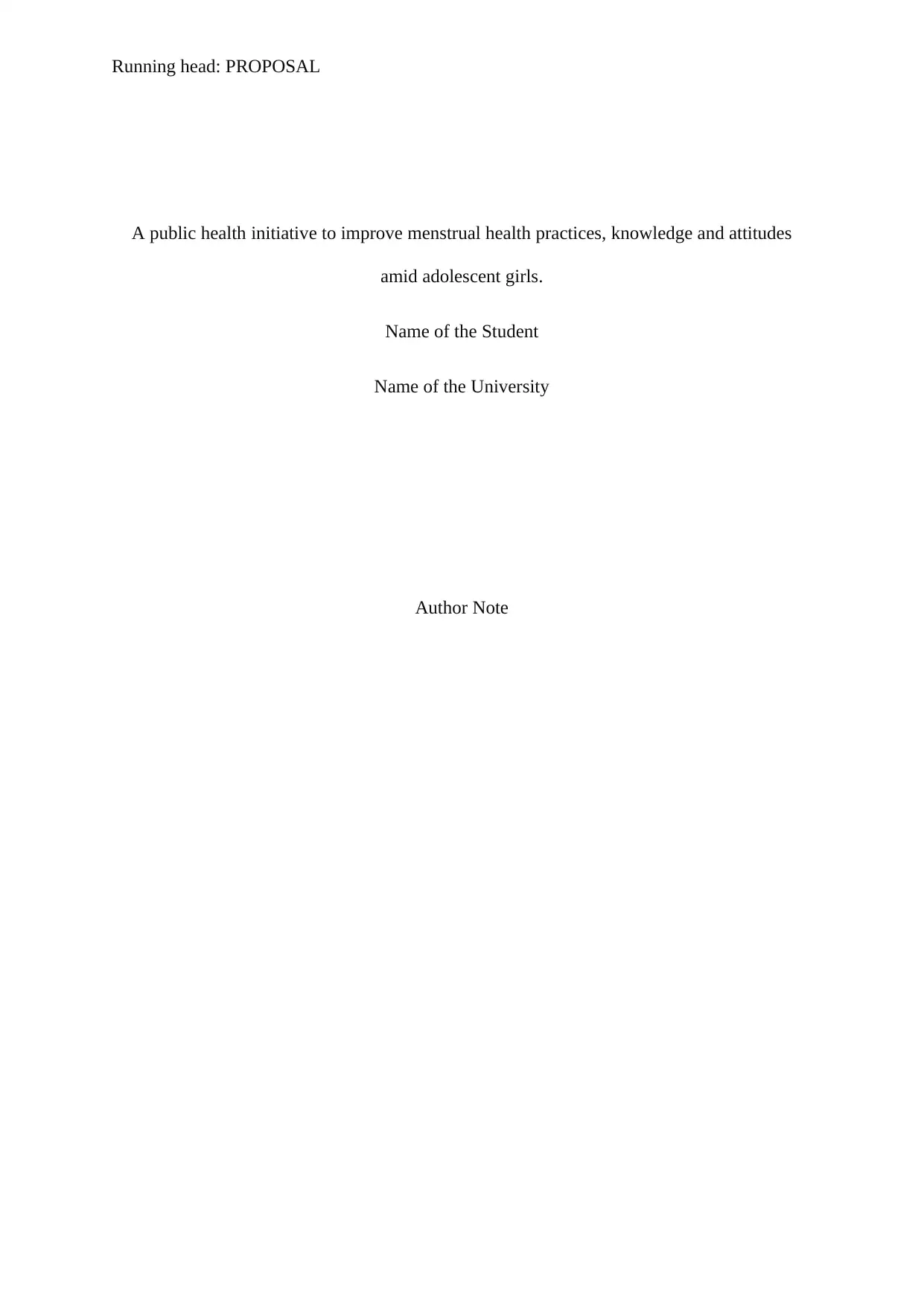
Running head: PROPOSAL
A public health initiative to improve menstrual health practices, knowledge and attitudes
amid adolescent girls.
Name of the Student
Name of the University
Author Note
A public health initiative to improve menstrual health practices, knowledge and attitudes
amid adolescent girls.
Name of the Student
Name of the University
Author Note
Paraphrase This Document
Need a fresh take? Get an instant paraphrase of this document with our AI Paraphraser
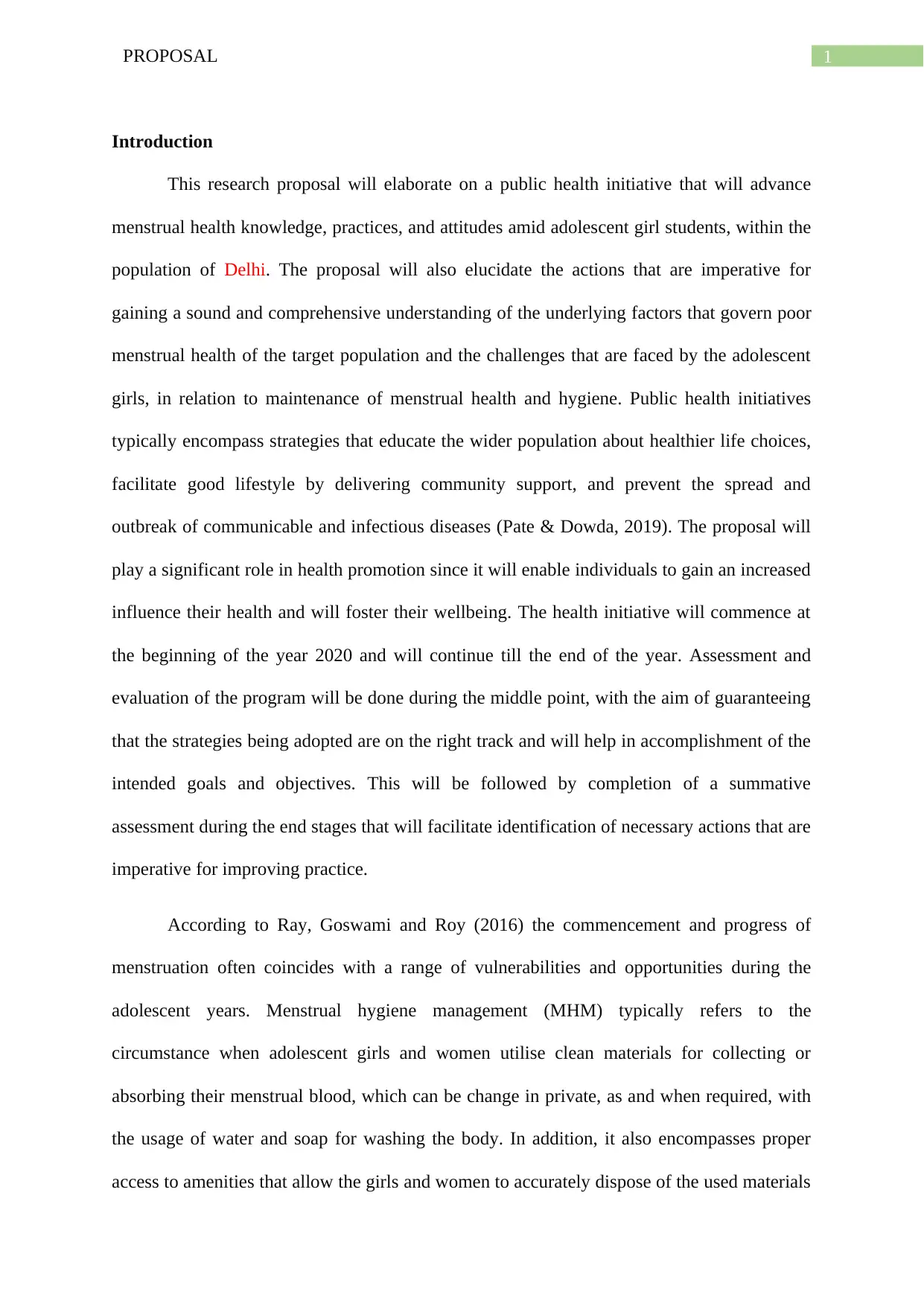
1PROPOSAL
Introduction
This research proposal will elaborate on a public health initiative that will advance
menstrual health knowledge, practices, and attitudes amid adolescent girl students, within the
population of Delhi. The proposal will also elucidate the actions that are imperative for
gaining a sound and comprehensive understanding of the underlying factors that govern poor
menstrual health of the target population and the challenges that are faced by the adolescent
girls, in relation to maintenance of menstrual health and hygiene. Public health initiatives
typically encompass strategies that educate the wider population about healthier life choices,
facilitate good lifestyle by delivering community support, and prevent the spread and
outbreak of communicable and infectious diseases (Pate & Dowda, 2019). The proposal will
play a significant role in health promotion since it will enable individuals to gain an increased
influence their health and will foster their wellbeing. The health initiative will commence at
the beginning of the year 2020 and will continue till the end of the year. Assessment and
evaluation of the program will be done during the middle point, with the aim of guaranteeing
that the strategies being adopted are on the right track and will help in accomplishment of the
intended goals and objectives. This will be followed by completion of a summative
assessment during the end stages that will facilitate identification of necessary actions that are
imperative for improving practice.
According to Ray, Goswami and Roy (2016) the commencement and progress of
menstruation often coincides with a range of vulnerabilities and opportunities during the
adolescent years. Menstrual hygiene management (MHM) typically refers to the
circumstance when adolescent girls and women utilise clean materials for collecting or
absorbing their menstrual blood, which can be change in private, as and when required, with
the usage of water and soap for washing the body. In addition, it also encompasses proper
access to amenities that allow the girls and women to accurately dispose of the used materials
Introduction
This research proposal will elaborate on a public health initiative that will advance
menstrual health knowledge, practices, and attitudes amid adolescent girl students, within the
population of Delhi. The proposal will also elucidate the actions that are imperative for
gaining a sound and comprehensive understanding of the underlying factors that govern poor
menstrual health of the target population and the challenges that are faced by the adolescent
girls, in relation to maintenance of menstrual health and hygiene. Public health initiatives
typically encompass strategies that educate the wider population about healthier life choices,
facilitate good lifestyle by delivering community support, and prevent the spread and
outbreak of communicable and infectious diseases (Pate & Dowda, 2019). The proposal will
play a significant role in health promotion since it will enable individuals to gain an increased
influence their health and will foster their wellbeing. The health initiative will commence at
the beginning of the year 2020 and will continue till the end of the year. Assessment and
evaluation of the program will be done during the middle point, with the aim of guaranteeing
that the strategies being adopted are on the right track and will help in accomplishment of the
intended goals and objectives. This will be followed by completion of a summative
assessment during the end stages that will facilitate identification of necessary actions that are
imperative for improving practice.
According to Ray, Goswami and Roy (2016) the commencement and progress of
menstruation often coincides with a range of vulnerabilities and opportunities during the
adolescent years. Menstrual hygiene management (MHM) typically refers to the
circumstance when adolescent girls and women utilise clean materials for collecting or
absorbing their menstrual blood, which can be change in private, as and when required, with
the usage of water and soap for washing the body. In addition, it also encompasses proper
access to amenities that allow the girls and women to accurately dispose of the used materials
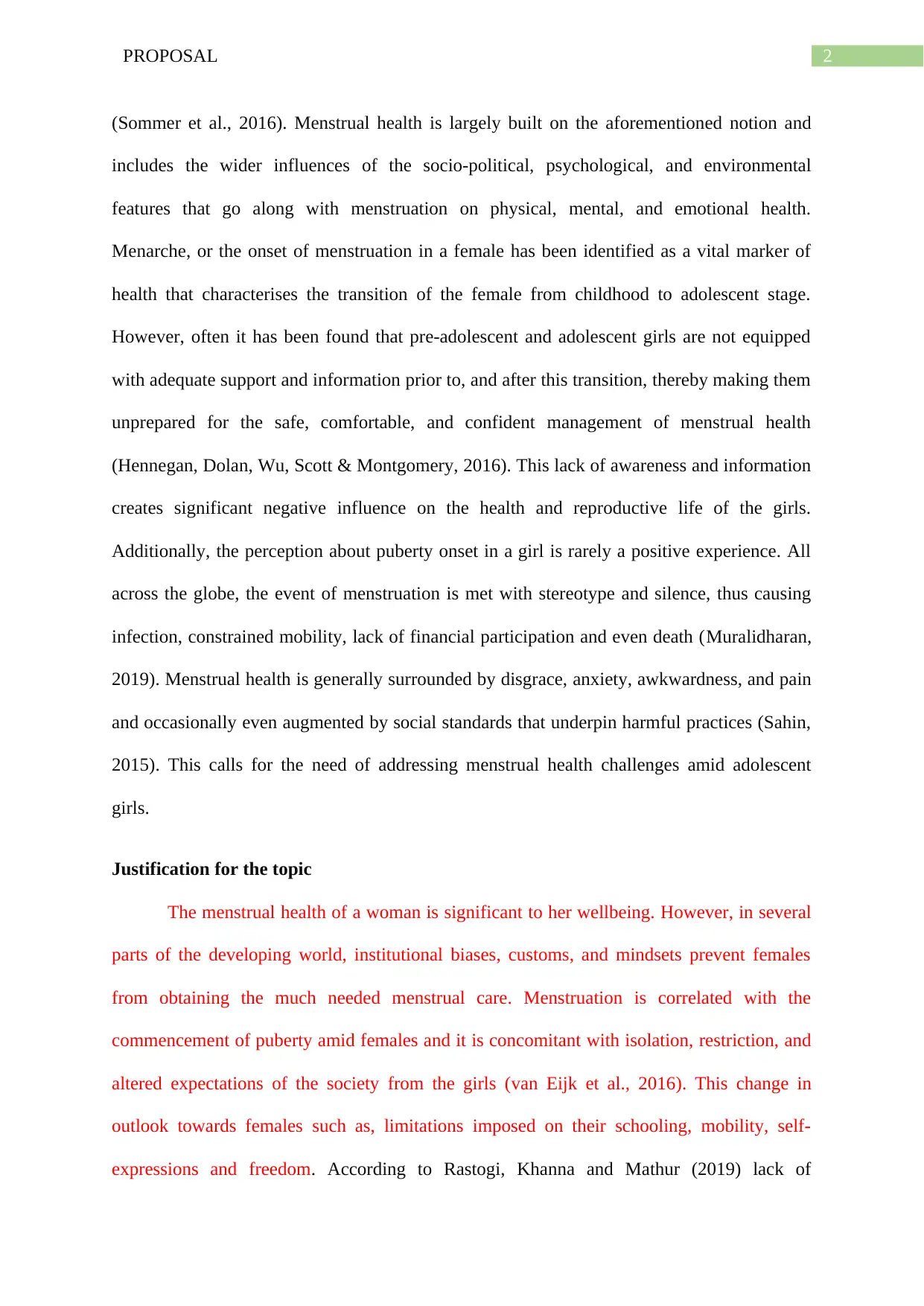
2PROPOSAL
(Sommer et al., 2016). Menstrual health is largely built on the aforementioned notion and
includes the wider influences of the socio-political, psychological, and environmental
features that go along with menstruation on physical, mental, and emotional health.
Menarche, or the onset of menstruation in a female has been identified as a vital marker of
health that characterises the transition of the female from childhood to adolescent stage.
However, often it has been found that pre-adolescent and adolescent girls are not equipped
with adequate support and information prior to, and after this transition, thereby making them
unprepared for the safe, comfortable, and confident management of menstrual health
(Hennegan, Dolan, Wu, Scott & Montgomery, 2016). This lack of awareness and information
creates significant negative influence on the health and reproductive life of the girls.
Additionally, the perception about puberty onset in a girl is rarely a positive experience. All
across the globe, the event of menstruation is met with stereotype and silence, thus causing
infection, constrained mobility, lack of financial participation and even death (Muralidharan,
2019). Menstrual health is generally surrounded by disgrace, anxiety, awkwardness, and pain
and occasionally even augmented by social standards that underpin harmful practices (Sahin,
2015). This calls for the need of addressing menstrual health challenges amid adolescent
girls.
Justification for the topic
The menstrual health of a woman is significant to her wellbeing. However, in several
parts of the developing world, institutional biases, customs, and mindsets prevent females
from obtaining the much needed menstrual care. Menstruation is correlated with the
commencement of puberty amid females and it is concomitant with isolation, restriction, and
altered expectations of the society from the girls (van Eijk et al., 2016). This change in
outlook towards females such as, limitations imposed on their schooling, mobility, self-
expressions and freedom. According to Rastogi, Khanna and Mathur (2019) lack of
(Sommer et al., 2016). Menstrual health is largely built on the aforementioned notion and
includes the wider influences of the socio-political, psychological, and environmental
features that go along with menstruation on physical, mental, and emotional health.
Menarche, or the onset of menstruation in a female has been identified as a vital marker of
health that characterises the transition of the female from childhood to adolescent stage.
However, often it has been found that pre-adolescent and adolescent girls are not equipped
with adequate support and information prior to, and after this transition, thereby making them
unprepared for the safe, comfortable, and confident management of menstrual health
(Hennegan, Dolan, Wu, Scott & Montgomery, 2016). This lack of awareness and information
creates significant negative influence on the health and reproductive life of the girls.
Additionally, the perception about puberty onset in a girl is rarely a positive experience. All
across the globe, the event of menstruation is met with stereotype and silence, thus causing
infection, constrained mobility, lack of financial participation and even death (Muralidharan,
2019). Menstrual health is generally surrounded by disgrace, anxiety, awkwardness, and pain
and occasionally even augmented by social standards that underpin harmful practices (Sahin,
2015). This calls for the need of addressing menstrual health challenges amid adolescent
girls.
Justification for the topic
The menstrual health of a woman is significant to her wellbeing. However, in several
parts of the developing world, institutional biases, customs, and mindsets prevent females
from obtaining the much needed menstrual care. Menstruation is correlated with the
commencement of puberty amid females and it is concomitant with isolation, restriction, and
altered expectations of the society from the girls (van Eijk et al., 2016). This change in
outlook towards females such as, limitations imposed on their schooling, mobility, self-
expressions and freedom. According to Rastogi, Khanna and Mathur (2019) lack of
⊘ This is a preview!⊘
Do you want full access?
Subscribe today to unlock all pages.

Trusted by 1+ million students worldwide
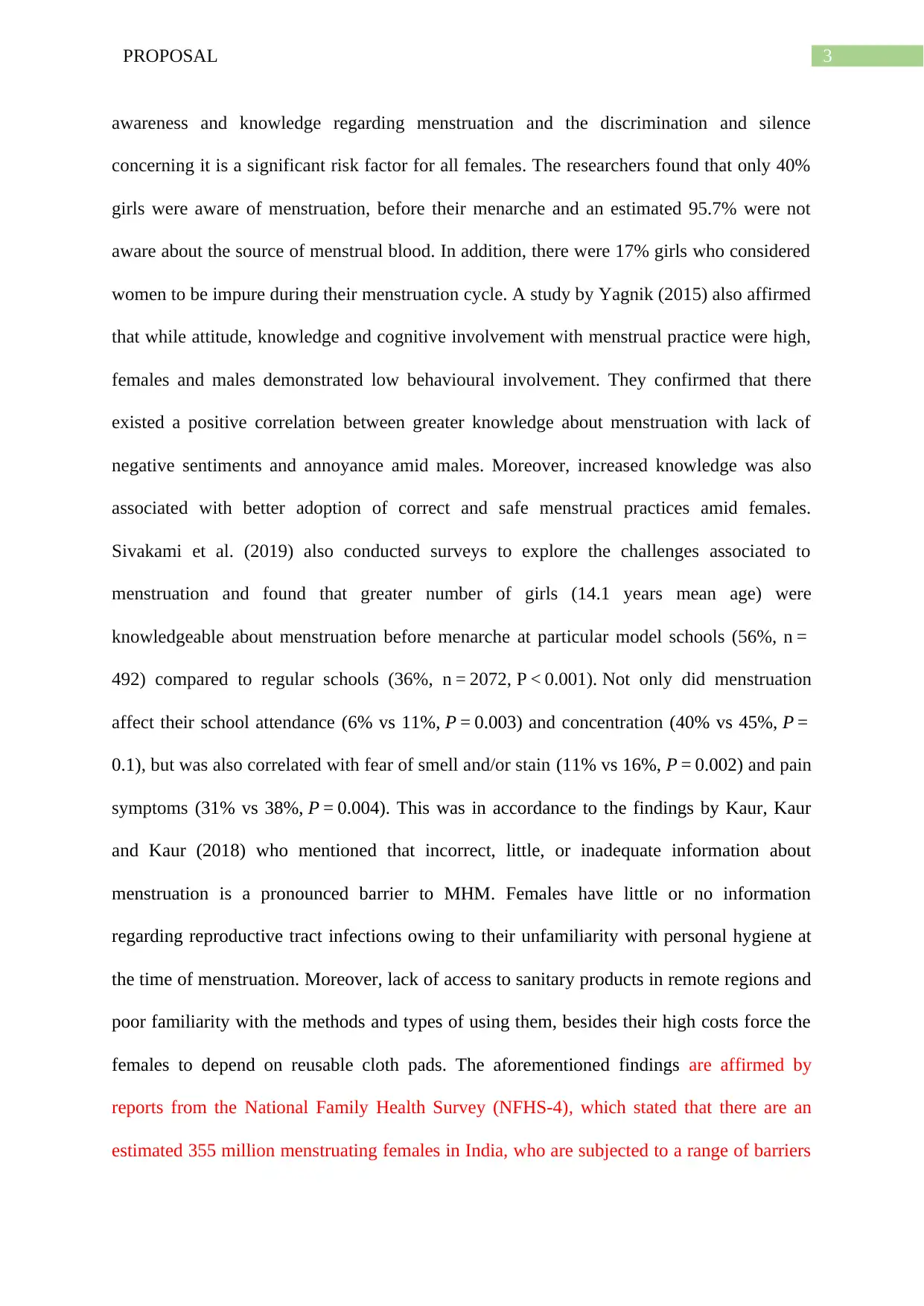
3PROPOSAL
awareness and knowledge regarding menstruation and the discrimination and silence
concerning it is a significant risk factor for all females. The researchers found that only 40%
girls were aware of menstruation, before their menarche and an estimated 95.7% were not
aware about the source of menstrual blood. In addition, there were 17% girls who considered
women to be impure during their menstruation cycle. A study by Yagnik (2015) also affirmed
that while attitude, knowledge and cognitive involvement with menstrual practice were high,
females and males demonstrated low behavioural involvement. They confirmed that there
existed a positive correlation between greater knowledge about menstruation with lack of
negative sentiments and annoyance amid males. Moreover, increased knowledge was also
associated with better adoption of correct and safe menstrual practices amid females.
Sivakami et al. (2019) also conducted surveys to explore the challenges associated to
menstruation and found that greater number of girls (14.1 years mean age) were
knowledgeable about menstruation before menarche at particular model schools (56%, n =
492) compared to regular schools (36%, n = 2072, P < 0.001). Not only did menstruation
affect their school attendance (6% vs 11%, P = 0.003) and concentration (40% vs 45%, P =
0.1), but was also correlated with fear of smell and/or stain (11% vs 16%, P = 0.002) and pain
symptoms (31% vs 38%, P = 0.004). This was in accordance to the findings by Kaur, Kaur
and Kaur (2018) who mentioned that incorrect, little, or inadequate information about
menstruation is a pronounced barrier to MHM. Females have little or no information
regarding reproductive tract infections owing to their unfamiliarity with personal hygiene at
the time of menstruation. Moreover, lack of access to sanitary products in remote regions and
poor familiarity with the methods and types of using them, besides their high costs force the
females to depend on reusable cloth pads. The aforementioned findings are affirmed by
reports from the National Family Health Survey (NFHS-4), which stated that there are an
estimated 355 million menstruating females in India, who are subjected to a range of barriers
awareness and knowledge regarding menstruation and the discrimination and silence
concerning it is a significant risk factor for all females. The researchers found that only 40%
girls were aware of menstruation, before their menarche and an estimated 95.7% were not
aware about the source of menstrual blood. In addition, there were 17% girls who considered
women to be impure during their menstruation cycle. A study by Yagnik (2015) also affirmed
that while attitude, knowledge and cognitive involvement with menstrual practice were high,
females and males demonstrated low behavioural involvement. They confirmed that there
existed a positive correlation between greater knowledge about menstruation with lack of
negative sentiments and annoyance amid males. Moreover, increased knowledge was also
associated with better adoption of correct and safe menstrual practices amid females.
Sivakami et al. (2019) also conducted surveys to explore the challenges associated to
menstruation and found that greater number of girls (14.1 years mean age) were
knowledgeable about menstruation before menarche at particular model schools (56%, n =
492) compared to regular schools (36%, n = 2072, P < 0.001). Not only did menstruation
affect their school attendance (6% vs 11%, P = 0.003) and concentration (40% vs 45%, P =
0.1), but was also correlated with fear of smell and/or stain (11% vs 16%, P = 0.002) and pain
symptoms (31% vs 38%, P = 0.004). This was in accordance to the findings by Kaur, Kaur
and Kaur (2018) who mentioned that incorrect, little, or inadequate information about
menstruation is a pronounced barrier to MHM. Females have little or no information
regarding reproductive tract infections owing to their unfamiliarity with personal hygiene at
the time of menstruation. Moreover, lack of access to sanitary products in remote regions and
poor familiarity with the methods and types of using them, besides their high costs force the
females to depend on reusable cloth pads. The aforementioned findings are affirmed by
reports from the National Family Health Survey (NFHS-4), which stated that there are an
estimated 355 million menstruating females in India, who are subjected to a range of barriers
Paraphrase This Document
Need a fresh take? Get an instant paraphrase of this document with our AI Paraphraser
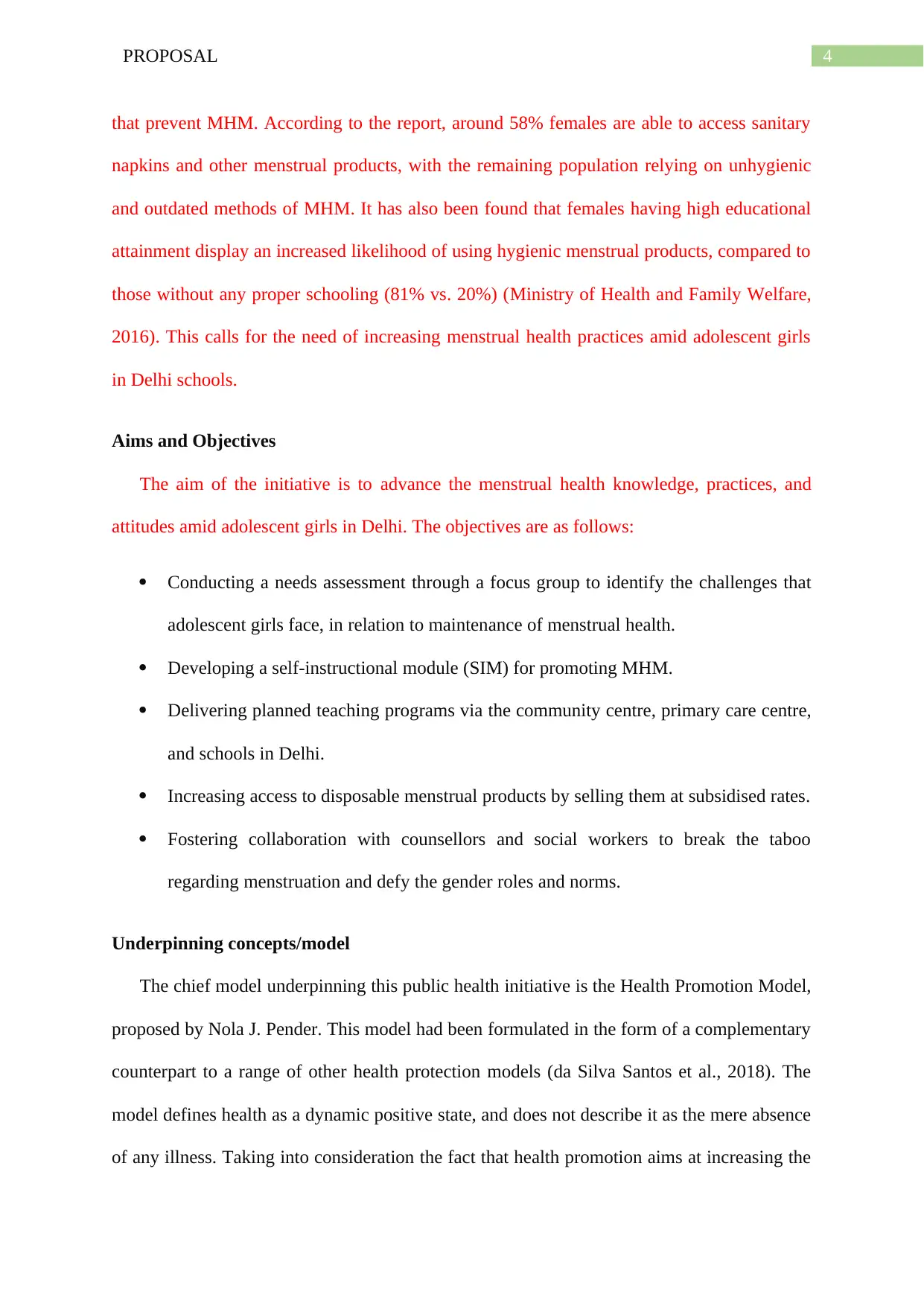
4PROPOSAL
that prevent MHM. According to the report, around 58% females are able to access sanitary
napkins and other menstrual products, with the remaining population relying on unhygienic
and outdated methods of MHM. It has also been found that females having high educational
attainment display an increased likelihood of using hygienic menstrual products, compared to
those without any proper schooling (81% vs. 20%) (Ministry of Health and Family Welfare,
2016). This calls for the need of increasing menstrual health practices amid adolescent girls
in Delhi schools.
Aims and Objectives
The aim of the initiative is to advance the menstrual health knowledge, practices, and
attitudes amid adolescent girls in Delhi. The objectives are as follows:
Conducting a needs assessment through a focus group to identify the challenges that
adolescent girls face, in relation to maintenance of menstrual health.
Developing a self-instructional module (SIM) for promoting MHM.
Delivering planned teaching programs via the community centre, primary care centre,
and schools in Delhi.
Increasing access to disposable menstrual products by selling them at subsidised rates.
Fostering collaboration with counsellors and social workers to break the taboo
regarding menstruation and defy the gender roles and norms.
Underpinning concepts/model
The chief model underpinning this public health initiative is the Health Promotion Model,
proposed by Nola J. Pender. This model had been formulated in the form of a complementary
counterpart to a range of other health protection models (da Silva Santos et al., 2018). The
model defines health as a dynamic positive state, and does not describe it as the mere absence
of any illness. Taking into consideration the fact that health promotion aims at increasing the
that prevent MHM. According to the report, around 58% females are able to access sanitary
napkins and other menstrual products, with the remaining population relying on unhygienic
and outdated methods of MHM. It has also been found that females having high educational
attainment display an increased likelihood of using hygienic menstrual products, compared to
those without any proper schooling (81% vs. 20%) (Ministry of Health and Family Welfare,
2016). This calls for the need of increasing menstrual health practices amid adolescent girls
in Delhi schools.
Aims and Objectives
The aim of the initiative is to advance the menstrual health knowledge, practices, and
attitudes amid adolescent girls in Delhi. The objectives are as follows:
Conducting a needs assessment through a focus group to identify the challenges that
adolescent girls face, in relation to maintenance of menstrual health.
Developing a self-instructional module (SIM) for promoting MHM.
Delivering planned teaching programs via the community centre, primary care centre,
and schools in Delhi.
Increasing access to disposable menstrual products by selling them at subsidised rates.
Fostering collaboration with counsellors and social workers to break the taboo
regarding menstruation and defy the gender roles and norms.
Underpinning concepts/model
The chief model underpinning this public health initiative is the Health Promotion Model,
proposed by Nola J. Pender. This model had been formulated in the form of a complementary
counterpart to a range of other health protection models (da Silva Santos et al., 2018). The
model defines health as a dynamic positive state, and does not describe it as the mere absence
of any illness. Taking into consideration the fact that health promotion aims at increasing the
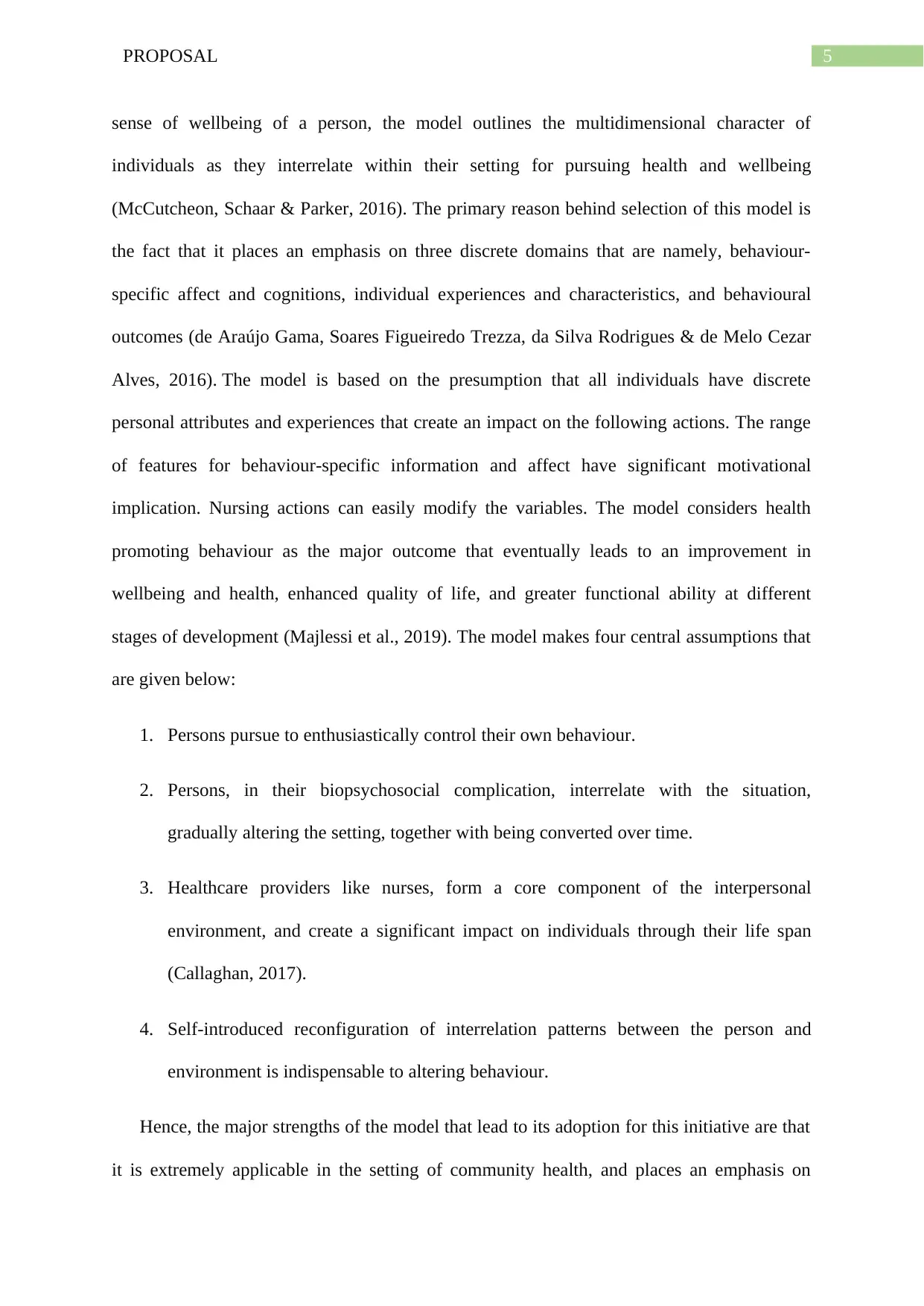
5PROPOSAL
sense of wellbeing of a person, the model outlines the multidimensional character of
individuals as they interrelate within their setting for pursuing health and wellbeing
(McCutcheon, Schaar & Parker, 2016). The primary reason behind selection of this model is
the fact that it places an emphasis on three discrete domains that are namely, behaviour-
specific affect and cognitions, individual experiences and characteristics, and behavioural
outcomes (de Araújo Gama, Soares Figueiredo Trezza, da Silva Rodrigues & de Melo Cezar
Alves, 2016). The model is based on the presumption that all individuals have discrete
personal attributes and experiences that create an impact on the following actions. The range
of features for behaviour-specific information and affect have significant motivational
implication. Nursing actions can easily modify the variables. The model considers health
promoting behaviour as the major outcome that eventually leads to an improvement in
wellbeing and health, enhanced quality of life, and greater functional ability at different
stages of development (Majlessi et al., 2019). The model makes four central assumptions that
are given below:
1. Persons pursue to enthusiastically control their own behaviour.
2. Persons, in their biopsychosocial complication, interrelate with the situation,
gradually altering the setting, together with being converted over time.
3. Healthcare providers like nurses, form a core component of the interpersonal
environment, and create a significant impact on individuals through their life span
(Callaghan, 2017).
4. Self-introduced reconfiguration of interrelation patterns between the person and
environment is indispensable to altering behaviour.
Hence, the major strengths of the model that lead to its adoption for this initiative are that
it is extremely applicable in the setting of community health, and places an emphasis on
sense of wellbeing of a person, the model outlines the multidimensional character of
individuals as they interrelate within their setting for pursuing health and wellbeing
(McCutcheon, Schaar & Parker, 2016). The primary reason behind selection of this model is
the fact that it places an emphasis on three discrete domains that are namely, behaviour-
specific affect and cognitions, individual experiences and characteristics, and behavioural
outcomes (de Araújo Gama, Soares Figueiredo Trezza, da Silva Rodrigues & de Melo Cezar
Alves, 2016). The model is based on the presumption that all individuals have discrete
personal attributes and experiences that create an impact on the following actions. The range
of features for behaviour-specific information and affect have significant motivational
implication. Nursing actions can easily modify the variables. The model considers health
promoting behaviour as the major outcome that eventually leads to an improvement in
wellbeing and health, enhanced quality of life, and greater functional ability at different
stages of development (Majlessi et al., 2019). The model makes four central assumptions that
are given below:
1. Persons pursue to enthusiastically control their own behaviour.
2. Persons, in their biopsychosocial complication, interrelate with the situation,
gradually altering the setting, together with being converted over time.
3. Healthcare providers like nurses, form a core component of the interpersonal
environment, and create a significant impact on individuals through their life span
(Callaghan, 2017).
4. Self-introduced reconfiguration of interrelation patterns between the person and
environment is indispensable to altering behaviour.
Hence, the major strengths of the model that lead to its adoption for this initiative are that
it is extremely applicable in the setting of community health, and places an emphasis on
⊘ This is a preview!⊘
Do you want full access?
Subscribe today to unlock all pages.

Trusted by 1+ million students worldwide
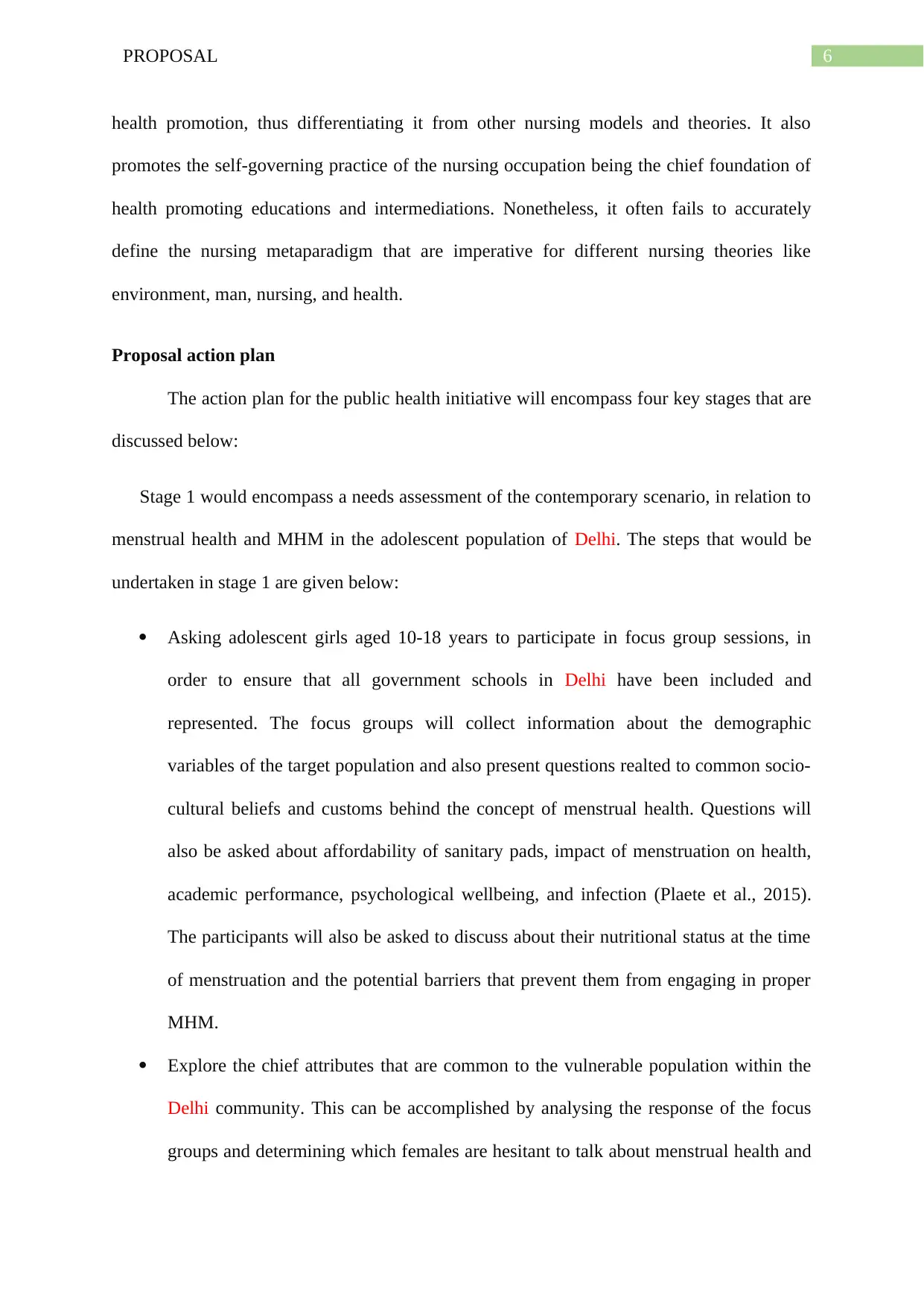
6PROPOSAL
health promotion, thus differentiating it from other nursing models and theories. It also
promotes the self-governing practice of the nursing occupation being the chief foundation of
health promoting educations and intermediations. Nonetheless, it often fails to accurately
define the nursing metaparadigm that are imperative for different nursing theories like
environment, man, nursing, and health.
Proposal action plan
The action plan for the public health initiative will encompass four key stages that are
discussed below:
Stage 1 would encompass a needs assessment of the contemporary scenario, in relation to
menstrual health and MHM in the adolescent population of Delhi. The steps that would be
undertaken in stage 1 are given below:
Asking adolescent girls aged 10-18 years to participate in focus group sessions, in
order to ensure that all government schools in Delhi have been included and
represented. The focus groups will collect information about the demographic
variables of the target population and also present questions realted to common socio-
cultural beliefs and customs behind the concept of menstrual health. Questions will
also be asked about affordability of sanitary pads, impact of menstruation on health,
academic performance, psychological wellbeing, and infection (Plaete et al., 2015).
The participants will also be asked to discuss about their nutritional status at the time
of menstruation and the potential barriers that prevent them from engaging in proper
MHM.
Explore the chief attributes that are common to the vulnerable population within the
Delhi community. This can be accomplished by analysing the response of the focus
groups and determining which females are hesitant to talk about menstrual health and
health promotion, thus differentiating it from other nursing models and theories. It also
promotes the self-governing practice of the nursing occupation being the chief foundation of
health promoting educations and intermediations. Nonetheless, it often fails to accurately
define the nursing metaparadigm that are imperative for different nursing theories like
environment, man, nursing, and health.
Proposal action plan
The action plan for the public health initiative will encompass four key stages that are
discussed below:
Stage 1 would encompass a needs assessment of the contemporary scenario, in relation to
menstrual health and MHM in the adolescent population of Delhi. The steps that would be
undertaken in stage 1 are given below:
Asking adolescent girls aged 10-18 years to participate in focus group sessions, in
order to ensure that all government schools in Delhi have been included and
represented. The focus groups will collect information about the demographic
variables of the target population and also present questions realted to common socio-
cultural beliefs and customs behind the concept of menstrual health. Questions will
also be asked about affordability of sanitary pads, impact of menstruation on health,
academic performance, psychological wellbeing, and infection (Plaete et al., 2015).
The participants will also be asked to discuss about their nutritional status at the time
of menstruation and the potential barriers that prevent them from engaging in proper
MHM.
Explore the chief attributes that are common to the vulnerable population within the
Delhi community. This can be accomplished by analysing the response of the focus
groups and determining which females are hesitant to talk about menstrual health and
Paraphrase This Document
Need a fresh take? Get an instant paraphrase of this document with our AI Paraphraser
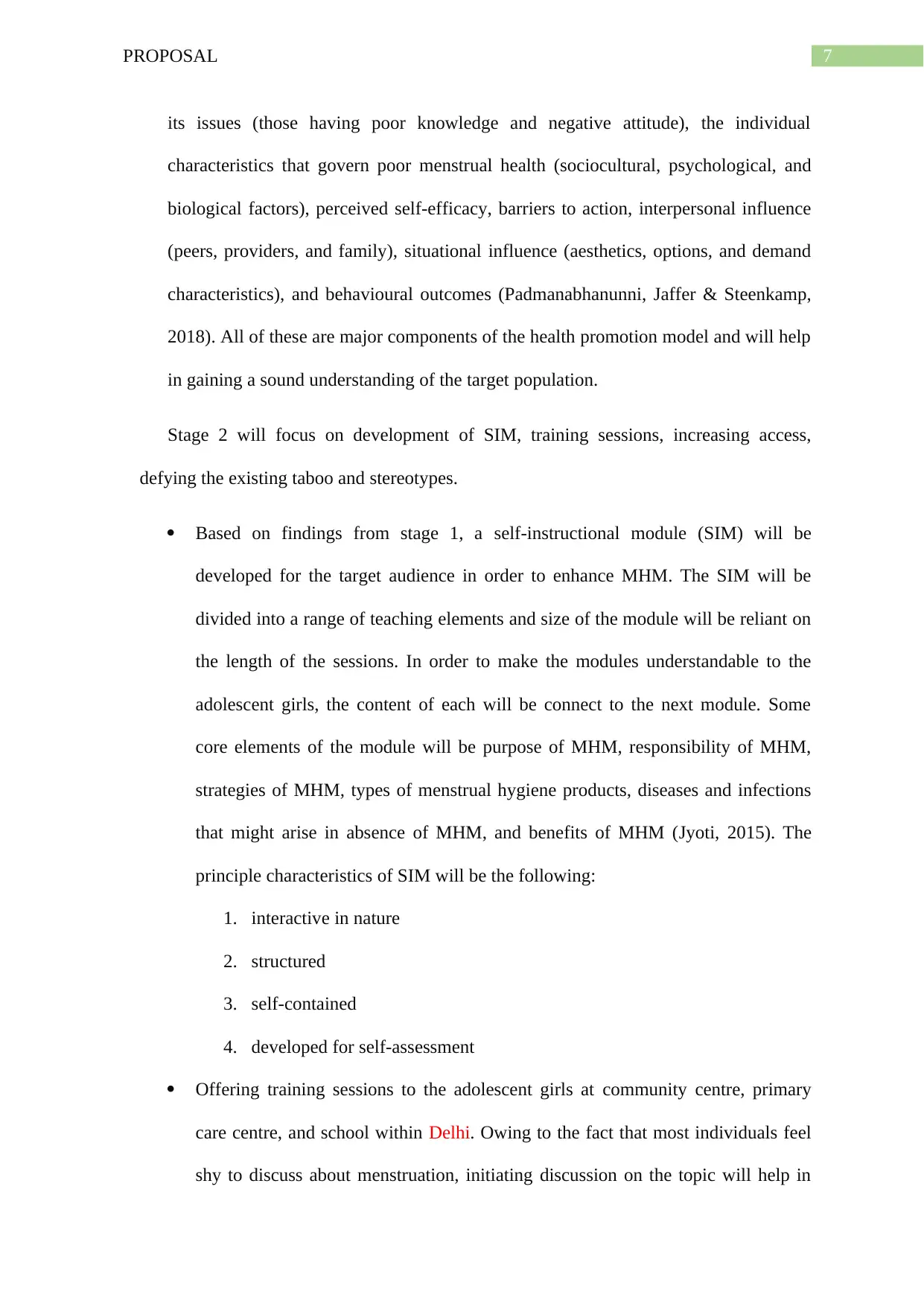
7PROPOSAL
its issues (those having poor knowledge and negative attitude), the individual
characteristics that govern poor menstrual health (sociocultural, psychological, and
biological factors), perceived self-efficacy, barriers to action, interpersonal influence
(peers, providers, and family), situational influence (aesthetics, options, and demand
characteristics), and behavioural outcomes (Padmanabhanunni, Jaffer & Steenkamp,
2018). All of these are major components of the health promotion model and will help
in gaining a sound understanding of the target population.
Stage 2 will focus on development of SIM, training sessions, increasing access,
defying the existing taboo and stereotypes.
Based on findings from stage 1, a self-instructional module (SIM) will be
developed for the target audience in order to enhance MHM. The SIM will be
divided into a range of teaching elements and size of the module will be reliant on
the length of the sessions. In order to make the modules understandable to the
adolescent girls, the content of each will be connect to the next module. Some
core elements of the module will be purpose of MHM, responsibility of MHM,
strategies of MHM, types of menstrual hygiene products, diseases and infections
that might arise in absence of MHM, and benefits of MHM (Jyoti, 2015). The
principle characteristics of SIM will be the following:
1. interactive in nature
2. structured
3. self-contained
4. developed for self-assessment
Offering training sessions to the adolescent girls at community centre, primary
care centre, and school within Delhi. Owing to the fact that most individuals feel
shy to discuss about menstruation, initiating discussion on the topic will help in
its issues (those having poor knowledge and negative attitude), the individual
characteristics that govern poor menstrual health (sociocultural, psychological, and
biological factors), perceived self-efficacy, barriers to action, interpersonal influence
(peers, providers, and family), situational influence (aesthetics, options, and demand
characteristics), and behavioural outcomes (Padmanabhanunni, Jaffer & Steenkamp,
2018). All of these are major components of the health promotion model and will help
in gaining a sound understanding of the target population.
Stage 2 will focus on development of SIM, training sessions, increasing access,
defying the existing taboo and stereotypes.
Based on findings from stage 1, a self-instructional module (SIM) will be
developed for the target audience in order to enhance MHM. The SIM will be
divided into a range of teaching elements and size of the module will be reliant on
the length of the sessions. In order to make the modules understandable to the
adolescent girls, the content of each will be connect to the next module. Some
core elements of the module will be purpose of MHM, responsibility of MHM,
strategies of MHM, types of menstrual hygiene products, diseases and infections
that might arise in absence of MHM, and benefits of MHM (Jyoti, 2015). The
principle characteristics of SIM will be the following:
1. interactive in nature
2. structured
3. self-contained
4. developed for self-assessment
Offering training sessions to the adolescent girls at community centre, primary
care centre, and school within Delhi. Owing to the fact that most individuals feel
shy to discuss about menstruation, initiating discussion on the topic will help in
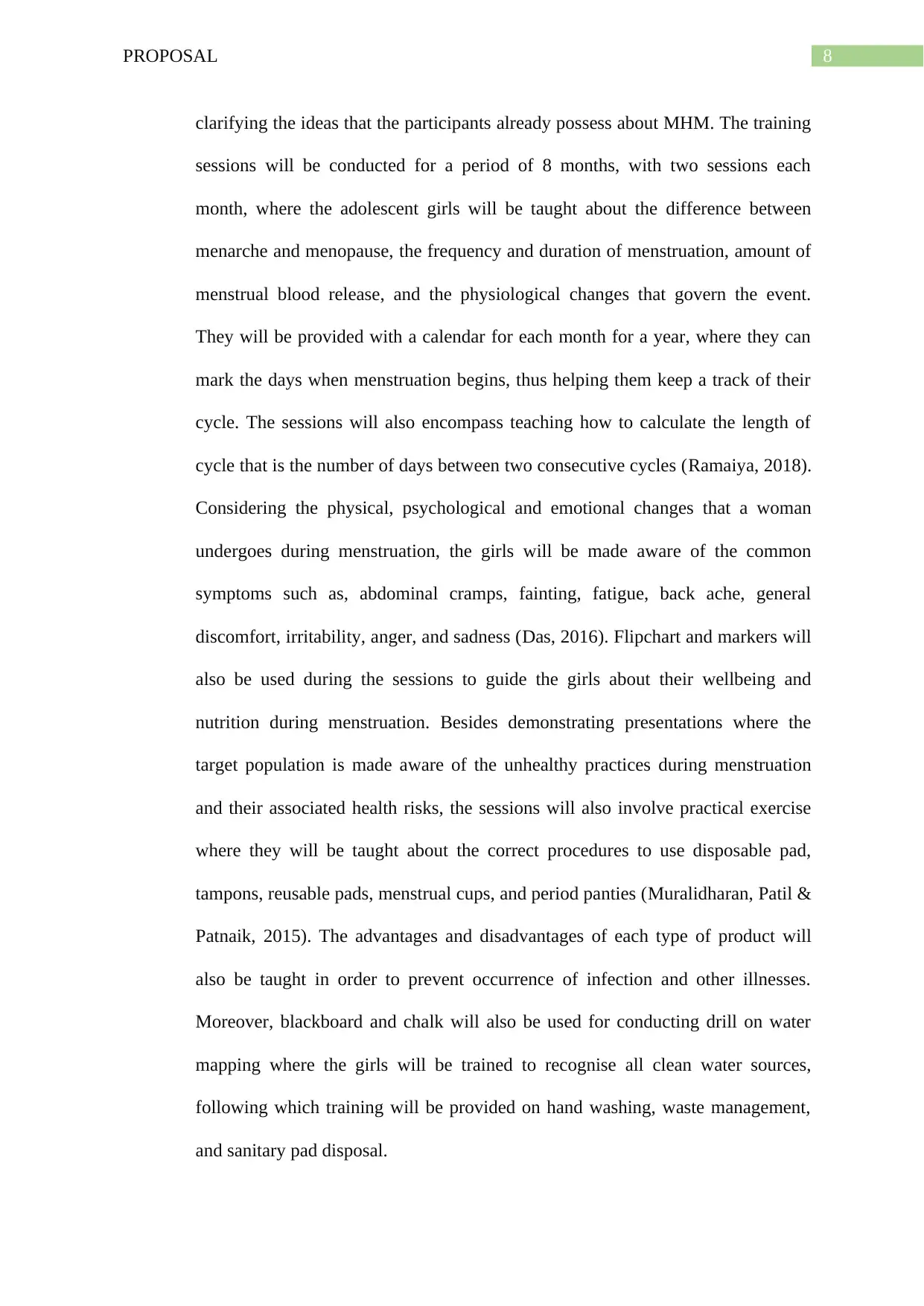
8PROPOSAL
clarifying the ideas that the participants already possess about MHM. The training
sessions will be conducted for a period of 8 months, with two sessions each
month, where the adolescent girls will be taught about the difference between
menarche and menopause, the frequency and duration of menstruation, amount of
menstrual blood release, and the physiological changes that govern the event.
They will be provided with a calendar for each month for a year, where they can
mark the days when menstruation begins, thus helping them keep a track of their
cycle. The sessions will also encompass teaching how to calculate the length of
cycle that is the number of days between two consecutive cycles (Ramaiya, 2018).
Considering the physical, psychological and emotional changes that a woman
undergoes during menstruation, the girls will be made aware of the common
symptoms such as, abdominal cramps, fainting, fatigue, back ache, general
discomfort, irritability, anger, and sadness (Das, 2016). Flipchart and markers will
also be used during the sessions to guide the girls about their wellbeing and
nutrition during menstruation. Besides demonstrating presentations where the
target population is made aware of the unhealthy practices during menstruation
and their associated health risks, the sessions will also involve practical exercise
where they will be taught about the correct procedures to use disposable pad,
tampons, reusable pads, menstrual cups, and period panties (Muralidharan, Patil &
Patnaik, 2015). The advantages and disadvantages of each type of product will
also be taught in order to prevent occurrence of infection and other illnesses.
Moreover, blackboard and chalk will also be used for conducting drill on water
mapping where the girls will be trained to recognise all clean water sources,
following which training will be provided on hand washing, waste management,
and sanitary pad disposal.
clarifying the ideas that the participants already possess about MHM. The training
sessions will be conducted for a period of 8 months, with two sessions each
month, where the adolescent girls will be taught about the difference between
menarche and menopause, the frequency and duration of menstruation, amount of
menstrual blood release, and the physiological changes that govern the event.
They will be provided with a calendar for each month for a year, where they can
mark the days when menstruation begins, thus helping them keep a track of their
cycle. The sessions will also encompass teaching how to calculate the length of
cycle that is the number of days between two consecutive cycles (Ramaiya, 2018).
Considering the physical, psychological and emotional changes that a woman
undergoes during menstruation, the girls will be made aware of the common
symptoms such as, abdominal cramps, fainting, fatigue, back ache, general
discomfort, irritability, anger, and sadness (Das, 2016). Flipchart and markers will
also be used during the sessions to guide the girls about their wellbeing and
nutrition during menstruation. Besides demonstrating presentations where the
target population is made aware of the unhealthy practices during menstruation
and their associated health risks, the sessions will also involve practical exercise
where they will be taught about the correct procedures to use disposable pad,
tampons, reusable pads, menstrual cups, and period panties (Muralidharan, Patil &
Patnaik, 2015). The advantages and disadvantages of each type of product will
also be taught in order to prevent occurrence of infection and other illnesses.
Moreover, blackboard and chalk will also be used for conducting drill on water
mapping where the girls will be trained to recognise all clean water sources,
following which training will be provided on hand washing, waste management,
and sanitary pad disposal.
⊘ This is a preview!⊘
Do you want full access?
Subscribe today to unlock all pages.

Trusted by 1+ million students worldwide
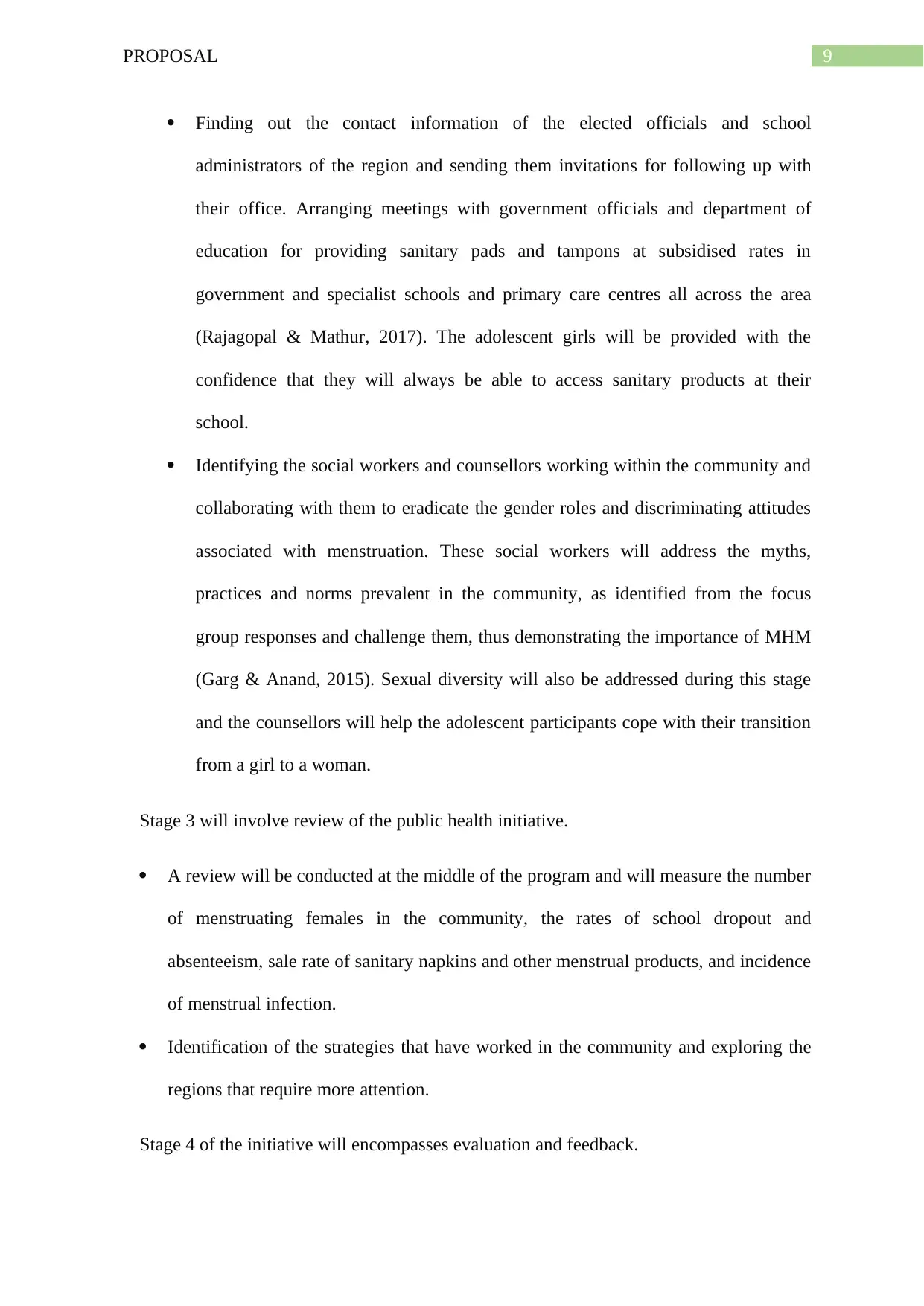
9PROPOSAL
Finding out the contact information of the elected officials and school
administrators of the region and sending them invitations for following up with
their office. Arranging meetings with government officials and department of
education for providing sanitary pads and tampons at subsidised rates in
government and specialist schools and primary care centres all across the area
(Rajagopal & Mathur, 2017). The adolescent girls will be provided with the
confidence that they will always be able to access sanitary products at their
school.
Identifying the social workers and counsellors working within the community and
collaborating with them to eradicate the gender roles and discriminating attitudes
associated with menstruation. These social workers will address the myths,
practices and norms prevalent in the community, as identified from the focus
group responses and challenge them, thus demonstrating the importance of MHM
(Garg & Anand, 2015). Sexual diversity will also be addressed during this stage
and the counsellors will help the adolescent participants cope with their transition
from a girl to a woman.
Stage 3 will involve review of the public health initiative.
A review will be conducted at the middle of the program and will measure the number
of menstruating females in the community, the rates of school dropout and
absenteeism, sale rate of sanitary napkins and other menstrual products, and incidence
of menstrual infection.
Identification of the strategies that have worked in the community and exploring the
regions that require more attention.
Stage 4 of the initiative will encompasses evaluation and feedback.
Finding out the contact information of the elected officials and school
administrators of the region and sending them invitations for following up with
their office. Arranging meetings with government officials and department of
education for providing sanitary pads and tampons at subsidised rates in
government and specialist schools and primary care centres all across the area
(Rajagopal & Mathur, 2017). The adolescent girls will be provided with the
confidence that they will always be able to access sanitary products at their
school.
Identifying the social workers and counsellors working within the community and
collaborating with them to eradicate the gender roles and discriminating attitudes
associated with menstruation. These social workers will address the myths,
practices and norms prevalent in the community, as identified from the focus
group responses and challenge them, thus demonstrating the importance of MHM
(Garg & Anand, 2015). Sexual diversity will also be addressed during this stage
and the counsellors will help the adolescent participants cope with their transition
from a girl to a woman.
Stage 3 will involve review of the public health initiative.
A review will be conducted at the middle of the program and will measure the number
of menstruating females in the community, the rates of school dropout and
absenteeism, sale rate of sanitary napkins and other menstrual products, and incidence
of menstrual infection.
Identification of the strategies that have worked in the community and exploring the
regions that require more attention.
Stage 4 of the initiative will encompasses evaluation and feedback.
Paraphrase This Document
Need a fresh take? Get an instant paraphrase of this document with our AI Paraphraser
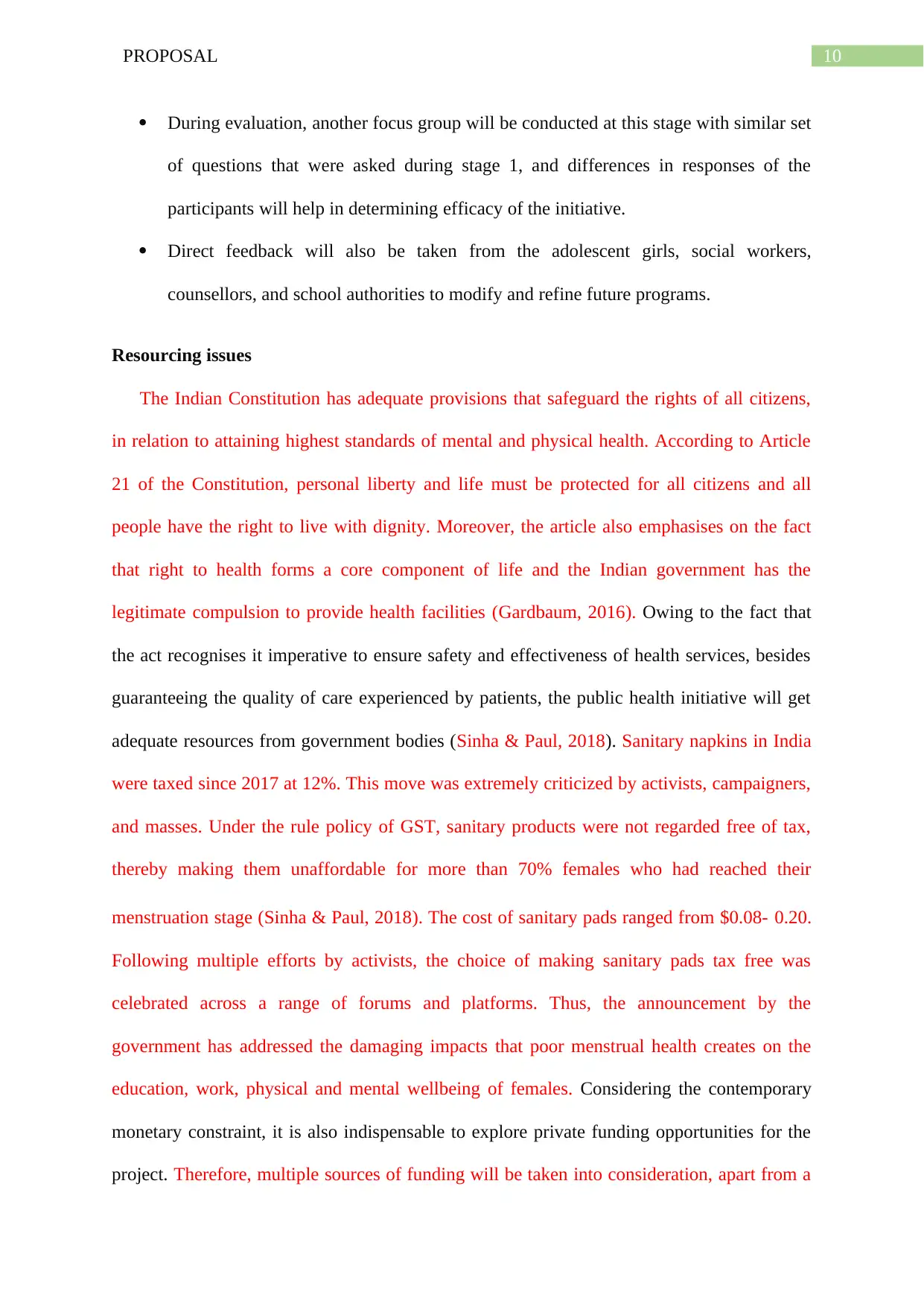
10PROPOSAL
During evaluation, another focus group will be conducted at this stage with similar set
of questions that were asked during stage 1, and differences in responses of the
participants will help in determining efficacy of the initiative.
Direct feedback will also be taken from the adolescent girls, social workers,
counsellors, and school authorities to modify and refine future programs.
Resourcing issues
The Indian Constitution has adequate provisions that safeguard the rights of all citizens,
in relation to attaining highest standards of mental and physical health. According to Article
21 of the Constitution, personal liberty and life must be protected for all citizens and all
people have the right to live with dignity. Moreover, the article also emphasises on the fact
that right to health forms a core component of life and the Indian government has the
legitimate compulsion to provide health facilities (Gardbaum, 2016). Owing to the fact that
the act recognises it imperative to ensure safety and effectiveness of health services, besides
guaranteeing the quality of care experienced by patients, the public health initiative will get
adequate resources from government bodies (Sinha & Paul, 2018). Sanitary napkins in India
were taxed since 2017 at 12%. This move was extremely criticized by activists, campaigners,
and masses. Under the rule policy of GST, sanitary products were not regarded free of tax,
thereby making them unaffordable for more than 70% females who had reached their
menstruation stage (Sinha & Paul, 2018). The cost of sanitary pads ranged from $0.08- 0.20.
Following multiple efforts by activists, the choice of making sanitary pads tax free was
celebrated across a range of forums and platforms. Thus, the announcement by the
government has addressed the damaging impacts that poor menstrual health creates on the
education, work, physical and mental wellbeing of females. Considering the contemporary
monetary constraint, it is also indispensable to explore private funding opportunities for the
project. Therefore, multiple sources of funding will be taken into consideration, apart from a
During evaluation, another focus group will be conducted at this stage with similar set
of questions that were asked during stage 1, and differences in responses of the
participants will help in determining efficacy of the initiative.
Direct feedback will also be taken from the adolescent girls, social workers,
counsellors, and school authorities to modify and refine future programs.
Resourcing issues
The Indian Constitution has adequate provisions that safeguard the rights of all citizens,
in relation to attaining highest standards of mental and physical health. According to Article
21 of the Constitution, personal liberty and life must be protected for all citizens and all
people have the right to live with dignity. Moreover, the article also emphasises on the fact
that right to health forms a core component of life and the Indian government has the
legitimate compulsion to provide health facilities (Gardbaum, 2016). Owing to the fact that
the act recognises it imperative to ensure safety and effectiveness of health services, besides
guaranteeing the quality of care experienced by patients, the public health initiative will get
adequate resources from government bodies (Sinha & Paul, 2018). Sanitary napkins in India
were taxed since 2017 at 12%. This move was extremely criticized by activists, campaigners,
and masses. Under the rule policy of GST, sanitary products were not regarded free of tax,
thereby making them unaffordable for more than 70% females who had reached their
menstruation stage (Sinha & Paul, 2018). The cost of sanitary pads ranged from $0.08- 0.20.
Following multiple efforts by activists, the choice of making sanitary pads tax free was
celebrated across a range of forums and platforms. Thus, the announcement by the
government has addressed the damaging impacts that poor menstrual health creates on the
education, work, physical and mental wellbeing of females. Considering the contemporary
monetary constraint, it is also indispensable to explore private funding opportunities for the
project. Therefore, multiple sources of funding will be taken into consideration, apart from a
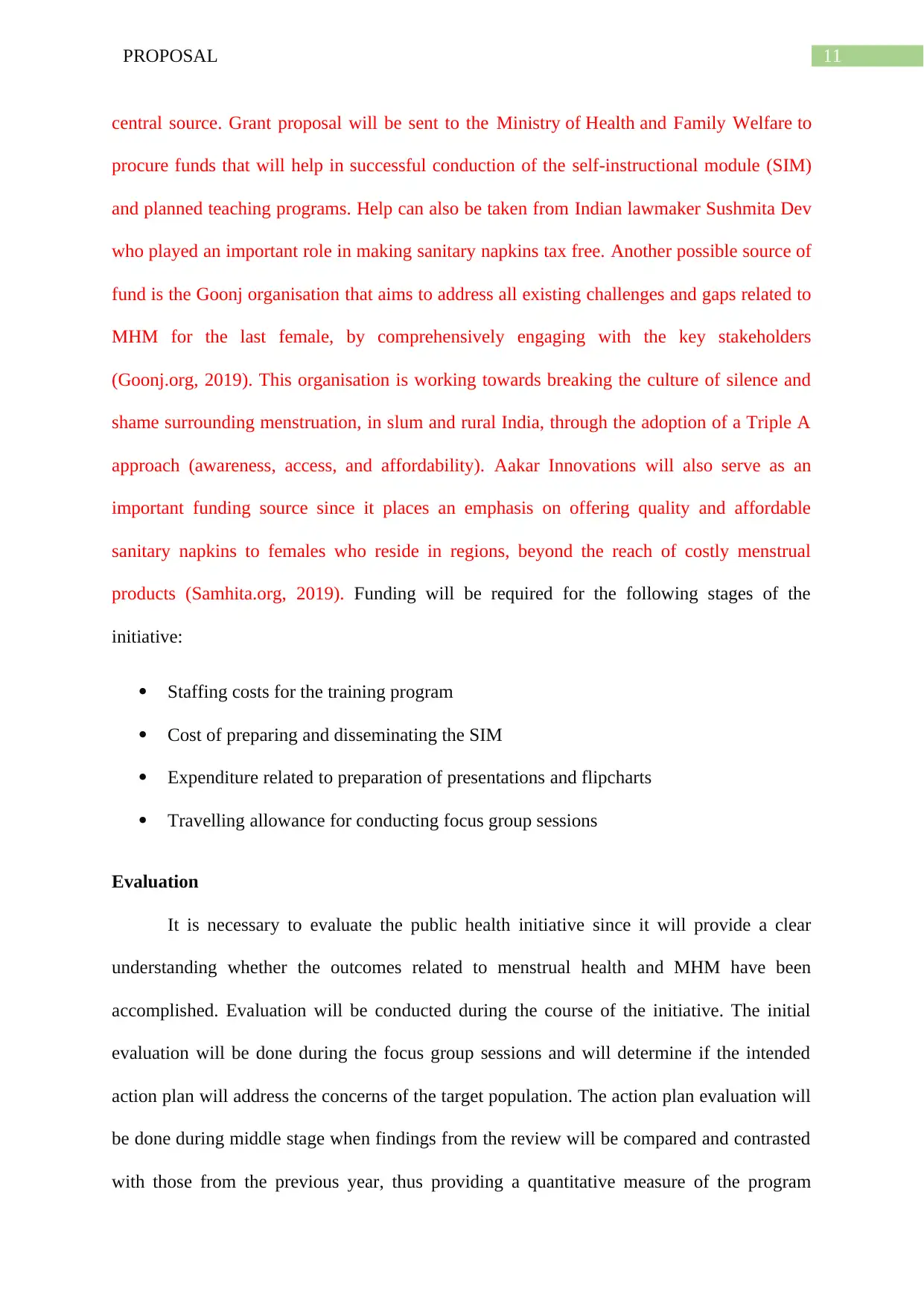
11PROPOSAL
central source. Grant proposal will be sent to the Ministry of Health and Family Welfare to
procure funds that will help in successful conduction of the self-instructional module (SIM)
and planned teaching programs. Help can also be taken from Indian lawmaker Sushmita Dev
who played an important role in making sanitary napkins tax free. Another possible source of
fund is the Goonj organisation that aims to address all existing challenges and gaps related to
MHM for the last female, by comprehensively engaging with the key stakeholders
(Goonj.org, 2019). This organisation is working towards breaking the culture of silence and
shame surrounding menstruation, in slum and rural India, through the adoption of a Triple A
approach (awareness, access, and affordability). Aakar Innovations will also serve as an
important funding source since it places an emphasis on offering quality and affordable
sanitary napkins to females who reside in regions, beyond the reach of costly menstrual
products (Samhita.org, 2019). Funding will be required for the following stages of the
initiative:
Staffing costs for the training program
Cost of preparing and disseminating the SIM
Expenditure related to preparation of presentations and flipcharts
Travelling allowance for conducting focus group sessions
Evaluation
It is necessary to evaluate the public health initiative since it will provide a clear
understanding whether the outcomes related to menstrual health and MHM have been
accomplished. Evaluation will be conducted during the course of the initiative. The initial
evaluation will be done during the focus group sessions and will determine if the intended
action plan will address the concerns of the target population. The action plan evaluation will
be done during middle stage when findings from the review will be compared and contrasted
with those from the previous year, thus providing a quantitative measure of the program
central source. Grant proposal will be sent to the Ministry of Health and Family Welfare to
procure funds that will help in successful conduction of the self-instructional module (SIM)
and planned teaching programs. Help can also be taken from Indian lawmaker Sushmita Dev
who played an important role in making sanitary napkins tax free. Another possible source of
fund is the Goonj organisation that aims to address all existing challenges and gaps related to
MHM for the last female, by comprehensively engaging with the key stakeholders
(Goonj.org, 2019). This organisation is working towards breaking the culture of silence and
shame surrounding menstruation, in slum and rural India, through the adoption of a Triple A
approach (awareness, access, and affordability). Aakar Innovations will also serve as an
important funding source since it places an emphasis on offering quality and affordable
sanitary napkins to females who reside in regions, beyond the reach of costly menstrual
products (Samhita.org, 2019). Funding will be required for the following stages of the
initiative:
Staffing costs for the training program
Cost of preparing and disseminating the SIM
Expenditure related to preparation of presentations and flipcharts
Travelling allowance for conducting focus group sessions
Evaluation
It is necessary to evaluate the public health initiative since it will provide a clear
understanding whether the outcomes related to menstrual health and MHM have been
accomplished. Evaluation will be conducted during the course of the initiative. The initial
evaluation will be done during the focus group sessions and will determine if the intended
action plan will address the concerns of the target population. The action plan evaluation will
be done during middle stage when findings from the review will be compared and contrasted
with those from the previous year, thus providing a quantitative measure of the program
⊘ This is a preview!⊘
Do you want full access?
Subscribe today to unlock all pages.

Trusted by 1+ million students worldwide
1 out of 19
Your All-in-One AI-Powered Toolkit for Academic Success.
+13062052269
info@desklib.com
Available 24*7 on WhatsApp / Email
![[object Object]](/_next/static/media/star-bottom.7253800d.svg)
Unlock your academic potential
Copyright © 2020–2025 A2Z Services. All Rights Reserved. Developed and managed by ZUCOL.